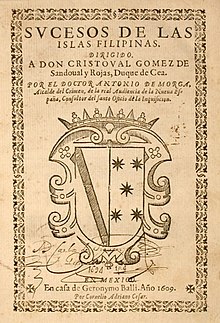Sucesos de las Islas Filipinas ('Events of the Philippine Islands') is a book written and published by Antonio de Morga considered one of the most important works on the early history of the Spanish colonization of the Philippines.[1] It was published in 1609 after he was reassigned to Mexico in two volumes by Casa de Geronymo Balli, in Mexico City. The first English translation was published in London in 1868 and another English translation by Blair and Robertson was published in Cleveland in 1907.[2]
 | |
| Author | Antonio De Morga |
|---|---|
| Original title | Sucesos de las Islas Filipinas |
| Language | Spanish |
| Genre | History |
| Publisher | Casa de Geronymo Balli |
Publication date | April 7, 1609 |
| Publication place | Mexico |
Published in English | 1868 |
| Media type | Manuscript |
| ISBN | 0-521-01035-7 |
The work greatly impressed but also garnered heavy criticism from Philippine national hero José Rizal who found it rife with erroneous claims and a eurocentric bias. Rizal decided to annotate it and publish a new edition and began working on it in London and completing it in Paris in 1890.[3][4]
History
editAntonio de Morga's Sucesos de las Islas Filipinas has been recognized as a first-hand account of Spanish colonial venture in Asia during the 16th century. The book was first published in Mexico in 1609 and has been re-edited number of times. The Hakluyt Society, a text publication society, in 1851 catches its attention, and an edition was prepared by H. E. J. Stanley but was only published in 1868.[5]
Sucesos de las Islas Filipinas is based on Antonio de Morga's personal experiences and other documentations from eye-witnesses of the events such as the survivors of Miguel López de Legazpi's Philippine expedition.[6]
Contents
editThe title literally means "Events of the Philippine Islands" and thus the book's primary goal is a documentation of events during the early years of the Spanish colonial period of the Philippines as observed by the author himself. It also includes Filipino customs, traditions, manners and religion at the time.[7]
References
edit- ^ de MORGA, Antonio (1890) [1609]. Sucesos de las Islas Filipinas (in Spanish). Annotated and reprinted by Dr José Rizal in Paris, 1890; another annotated edition by Wenceslao E RETANA in Madrid, 1910; first English translation by Sir Henry Edward John Stanley of Alderley published by Hakluyt Society of London, 1868; also reproduced in Blair & Robertson as vols XV and XVI. Mexico City: en casa de Gerónymo Balli : por Cornelio Adriano Cesar. ISBN 978-0521010351. OCLC 645286630.
- ^ BLAIR, Emma Helen & ROBERTSON, James Alexander, eds. (1904). The Philippine Islands, 1493–1898 (in Spanish). Vol. 15 of 55 (1609). Completely translated into English and annotated by the editors. Cleveland, Ohio: Arthur H. Clark Company. ISBN 978-1231213940. OCLC 769945706.
Explorations by early navigators, descriptions of the islands and their peoples, their history and records of the catholic missions, as related in contemporaneous books and manuscripts, showing the political, economic, commercial and religious conditions of those islands from their earliest relations with European nations to the close of the nineteenth century. — From their discovery by Magellan in 1521 to the beginning of the XVII Century; with descriptions of Japan, China and adjacent countries, by Dr. ANTONIO DE MORGA Alcalde of Criminal Causes, in the Royal Audiencia of Nueva Espana, and Counsel for the Holy Office of the Inquisition.
- ^ Ocampo, Ambeth R. "The indolence of the Filipino". opinion.inquirer.net. Retrieved 29 September 2019.
- ^ Morga, Antonio de (1890). Sucesos de las Islas Filipinas. Annotated by Rizal, José. Paris: Garnier Hermanos.
- ^ Cummins, J. S. (2017). Sucesos de las Islas Filipinas, 1609, by Antonio de Morga. Taylor & Francis. ISBN 9781317048541. Retrieved 29 September 2019.
- ^ History of the Philippine Islands Vols 1 and 2 (PDF). public-library.uk. Retrieved 29 September 2019.
- ^ Cummins, J.S. "Sucesos de las Islas Filipinas, 1609, by Antonio de Morga". CRC Press. Retrieved 29 September 2019.